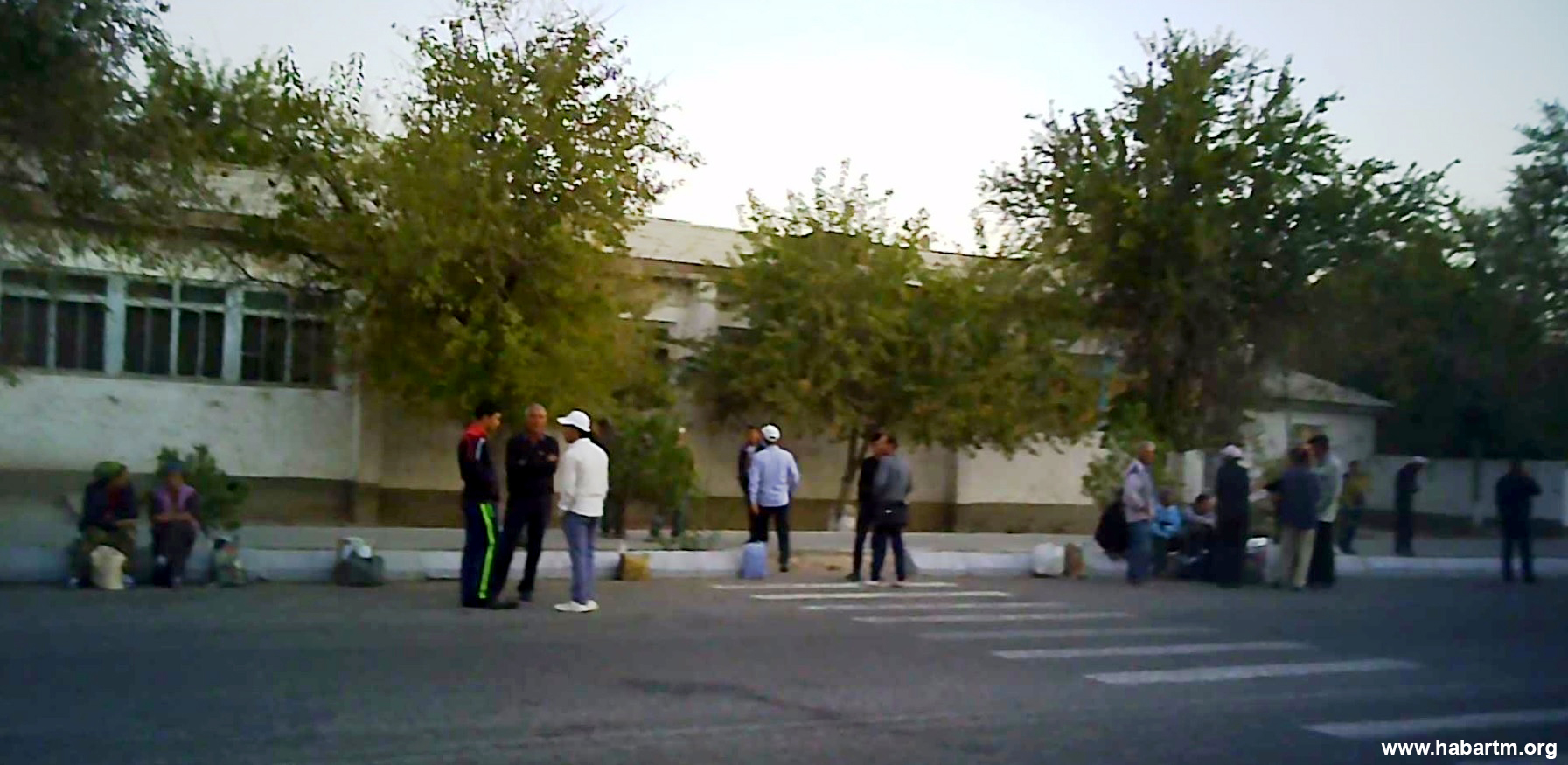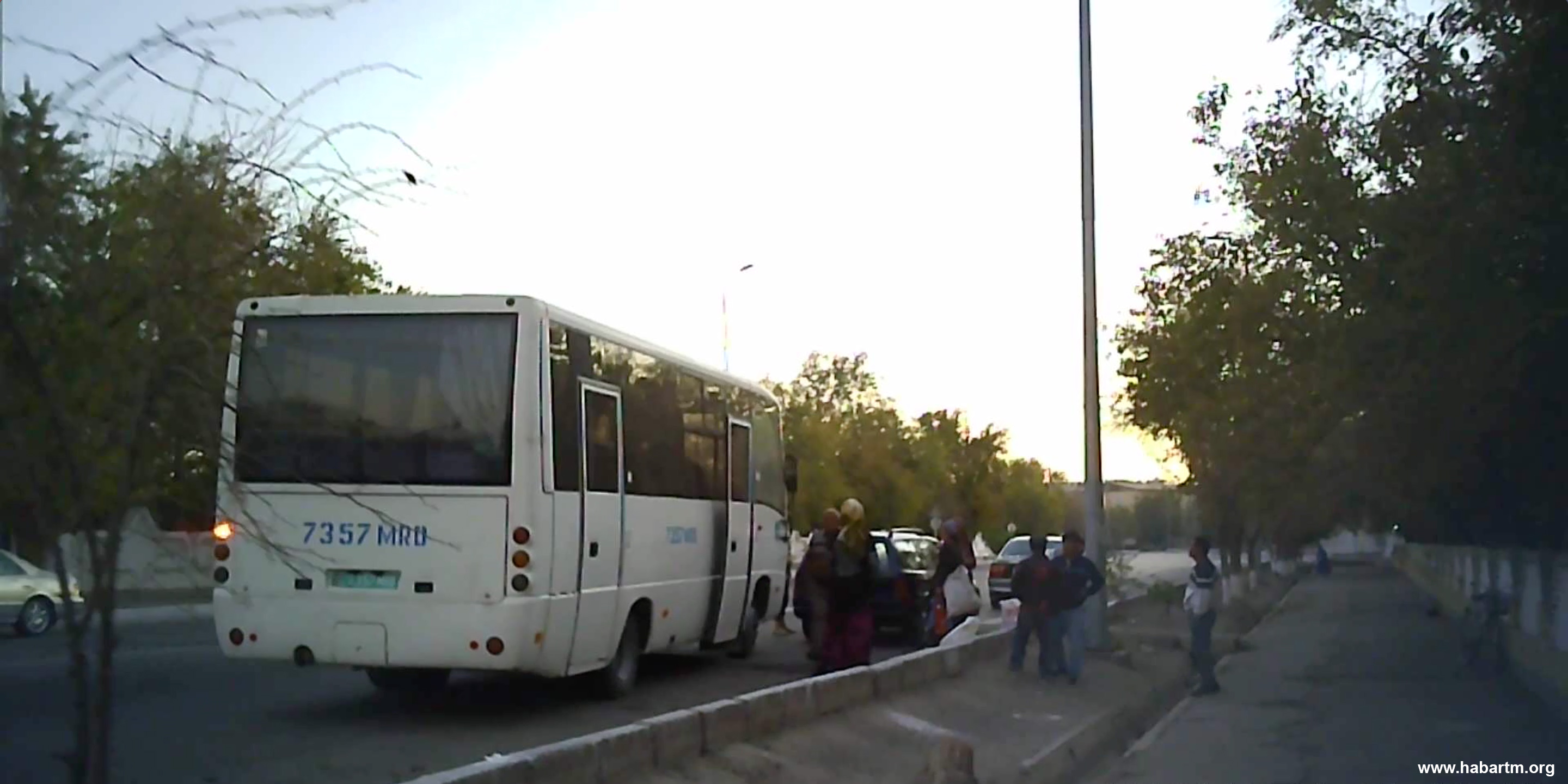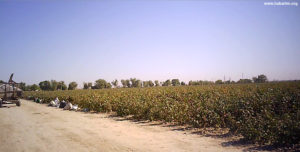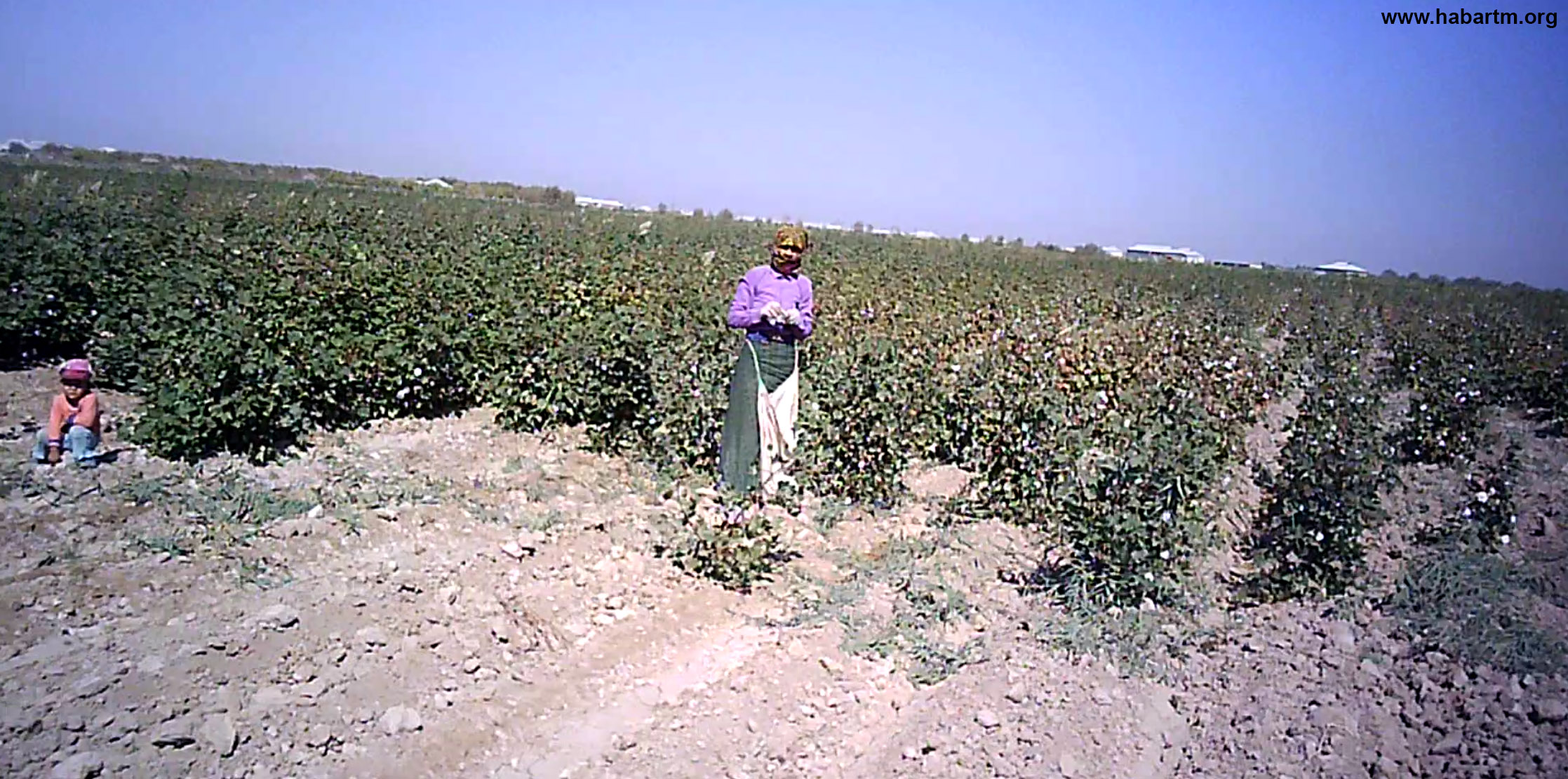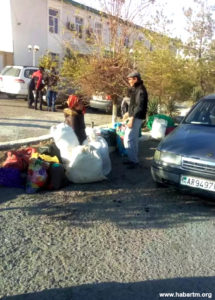Countries
Solidarity campaigns
Cotton pickers struggle with low pay, poor crop in southern Turkmenistan
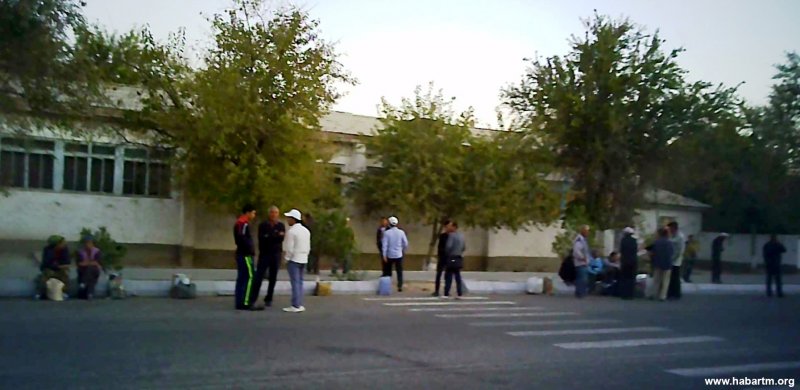
Harvesting by hand remains the norm in the cotton fields of Turkmenistan’s southern Mary region. Despite reports in the state-run media of the widespread use of cotton harvesters, observers for Alternative Turkmenistan News failed to find any evidence of the machines out in the fields. Instead, the observers estimate that some 5,600 public sector workers – teachers, doctors, cleaners and others – are forced to go cotton picking every day in the region. In addition, many workers are taken cotton picking for extended periods of 10 days or a month.
The ATN observers have spoken to forced laborers in Mary, who report a poor crop and low pay. There have been no triumphant harvest reports from the region yet this season. According to official figures, as of November 1st Mary region had met its state plan for cotton by only 80.5 per cent. The pickers, however, question the accuracy of even that total and speak of an entrenched system of inflated harvest figures.
ATN’s monitoring of the 2018 cotton season continues with this report from Mary region.
22 October
Every morning since the start of September secondary school teachers and support staff have been gathering outside School No. 14 in the city of Mary. This is just one of some 30 assembly points in the city where dozens of public sector staff gather to be taken cotton picking, either for a day shift or an extended period. Doctors, medical staff, and workers from all public sector organizations and enterprises go cotton picking.
There are some 80 people outside the school today. From time to time a state-owned bus from the local depot arrives, people are checked off against the lists and, if someone has hired someone else to go in their place, the hired worker says who he is replacing. But there aren’t many hired replacements today, nor have there been all season. Salaries are too low for people to afford to pay a replacement.
Ogulgerek, a cleaner at a town school, reveals the inefficiencies in the system. “We’re in luck today – we’re being taken to Sakarchage district, which is near the city, just 25 kilometres away. They try not to take school staff too far away as we have to come back in the evening. But the workers in the utilities, telecoms and industrial enterprises are taken much further and have to stay over – to Garagum district which is 60 kilometres away, or Yoloten which is 70, or to the back of beyond – Oguzhan district, which is over 100 kilometres away.
“Until around October 5th there wasn’t much cotton. At best you could pick 10 kg a day, but now it’s October you can pick 25-30 kg. The problem is that the fields there aren’t big and the tenant farmers can manage themselves. We’re not much help to them, but we’re still sent like clockwork. At one collective farm the tenant farmer refused outright to take us. He said he could pick all the cotton himself. We tried to insist and said that we’d been sent to him from the city. Then he said he would let us into the field but wouldn’t pay us. So with no hard feelings we got back on the bus and went to look for another field.”
Payment is a thorny issue. There’s a crisis in the country; prices are rising and wages are too small. Before they go into the fields the tenant farmer and pickers from the city agree on terms: either the farmer pays 0.20 manats a kilo, but provides water, tea and bread, or pays 0.30 manats, but the pickers don’t ask him for anything, not even water. It’s a tough negotiation; every minor detail is discussed, even how much cotton the tenant farmer will knock off during the weigh-in for moisture and impurities. People almost always choose the second option – pay of 0.30 manats, because it’s not a problem to bring food from home for a day’s harvesting. It’s easy: bread, a bunch of spring onions and one or two bottles of water.
“If that’s not slavery, I don’t know what is!”
Nurbibi (her name has been changed to protect her identity), a schoolteacher of Turkmen language and literature: “It poured down on Saturday and Sunday, October 6th and 7th. On Monday we were sent to pick cotton at the Ak Altyn farmers’ association in Mary district. We agreed on 0.30 manats with the tenant farmer. People worked all day without a break, but when it was time to hand in the cotton the farmer said that he would discount exactly half the harvest because of moisture. Many people complained and asked why he hadn’t warned us. People wouldn’t have worked so hard, standing all day up to their ankles in clay mud. But he wouldn’t budge: just give me my cotton then, he said, I didn’t ask you to come.
“The scales showed I had picked 40 kg, but the farmer wrote down 20 and paid me six manats exactly. Six manats! [32 U.S. cents according to the market rate] If that’s not slavery, I don’t know what is! Of course, the farmer tried to justify himself. He said the factory would knock off cotton too when he took it there, but they wouldn’t discount half the harvest! People went home tired, dirty and angry.”
An observer for Alternative Turkmenistan News recorded several similar incidents when pickers openly expressed their dissatisfaction over the moisture in the cotton. A worker at the Maryagyzsuv water supply company, Gurbangeldy (not his real name), said that from October 5th to 14thpractically the whole workforce had been taken to Yoloten district for ten days.
“People went in the hope that they could supplement their monthly salary of 600 manats [just over $32]. For example, during the entire season last year I managed to pick cotton worth two months’ salary. During this ten-day trip I picked 640 kg of cotton, from which the tenant farmer knocked off 140 kg for moisture, but the guys and I grabbed him by his lapels and said we’d done an honest job. It was really hard work picking all that cotton. In the end he just took off 40 kg and paid me 120 manats [$6.5] or the price of 4 kg of meat. It’s been a disastrous season for us.”
Bogus figures
Mary region is the biggest producer of cotton and in 2018 should produce 313,000 tonnes of raw cotton, according to the president’s order. When Turkmenistan’s main holiday, Independence Day, used to be celebrated on October 27th, the head of the regional administration and the heads of other cotton-growing regions would travel to Ashgabat the day before the holiday in order to report in person to the president on fulfilling the cotton plan. The ceremony became a tradition and was observed every year, regardless of whether the plan had been met or not.
In 2018 the holiday was brought forward by a month to the end of September. It was too early in the season to talk of fulfilling the plan. But at the end of October there were no victorious reports from regional governors either: no holiday, no reports. According to figures from Turkmenistan’s Ministry of Agriculture and Water Resources, as of November 1st in Mary region the state plan had been fulfilled only in Garagum district, while in the region as a whole the state order for cotton had been met by 80.5 per cent. This figure is further proof that all the October work reports in past years were bogus and the figures given there for harvested cotton were overstated. But did Garagum district actually manage to meet its target?
No combine harvesters in sight
On November 1st the state news agency Turkmenistan Today reported on the victory of cotton-growers in Garagum district who had handed over to the state more than 44,000 tonnes of raw material. The official press emphasizes that this year tenant farmers received “especially powerful technical support” in the form of 324 cotton-harvesting combines. “That’s 41 more machines than last year,” the press said.
An ATN observer went to the village of Gurtlydepe in Akmeydan association in Garagum district to talk to the local farmers.
Мuhammet (not his real name), a tenant farmer who leases three hectares of land, had not seen a harvester: “Not a single combine came to our fields, and certainly not at the start of the season, which is what the papers said. There wasn’t anything to pick in September and now we’ve picked everything ourselves. I often go to the farmers’ association office to report on the harvested cotton and sign for the services I’ve received from the state. I talk to my fellow farmers there and no one ever said anything to me about having a harvester in his field. As far as I know, there were no harvesters in the Baluchi fields, they always pick their own harvest. If they do bring in harvesters, that must be in Oguzhan district, as there aren’t many people there, but it’s not likely, because it’s not profitable for us tenant farmers either in terms of money or efficiency.
“It’s much cheaper to hire pickers from the city as they pick the cotton more cleanly. Before taking a harvester into the field, you have to use defoliants on the cotton plants so that their leaves fall off, and that means extra expenditure. And harvesters cannot turn round on our smallholdings – the farmers have small plots, 3 to 5 hectares, and there wasn’t much cotton this year either.”
The pickers who are forced into the fields by the local authorities to the detriment of their main jobs are also surprized at the absence of cotton harvesters. They think the media reports of “efficient, high-yield deployment of hundreds of modern cotton-picking machines” just as mendacious as the reports that people voluntarily go to pick cotton and are paid on time and in full.
Bossan, a childcare assistant at a preschool in the city of Bayramaly, has seen neither hide nor hair of a harvester: “We pickers from kindergartens and children’s day care centers are taken all over to pick cotton. We’ve worked in all the remote farmers’ associations in the district, but we’ve never seen groups of harvesters in the fields as are shown on TV. I’ve a relative working in TV in Ashgabat who’s told us how these TV clips are filmed. First they find an ideal field to film, one without reeds or other weeds; then they bring in all the district’s equipment; the harvester drivers are told to wear traditional khalats and skullcaps. It looks really good. In reality, the American and Uzbek harvesters, which were probably bought for tens, if not hundreds of millions of dollars, stand idle – either they don’t know how to use them or there’s nowhere suitable for them to work or it’s just not worth anyone’s while.
“But I know that the clips shown on TV are as much of a sham as all the reports about payments on time for tenant farmers and pickers. If you watch our TV, you’ll think that picking cotton is profitable, especially for the unemployed. And the rates don’t look bad – 0.60 manats for a picked kilogram. But that’s a lie too. It’s at least something if you get 0.20 manats per kilo. Sometimes you’re not paid at all. That’s why you don’t see people going willingly to the fields. We all go cotton picking either because we’re forced to or we’re hired.”
On November 2nd another observer expressed doubt about the district’s victorious report, citing people who had been taken from the town of Garagum to pick cotton in the district’s rural areas. The observer thinks it’s quite possible that the 44,000 tonnes supposedly in Garagum’s procurement centres do not actually exist.
Velmurat (not his real name), a worker at a kindergarten in the town of Garagum, saw a very poor crop: “In October we picked cotton in Garagum district, and I didn’t see any fields with a normal cotton crop. The bushes were very short, between 25 and 30 centimeters, and they had only one or two bolls each. It’s obvious that the plants were missing something – either water or fertilizer. I can’t see how the district could have fulfilled the plan with that quality of crop.”
Meanwhile, on November 5th state media reported that one million tonnes of cotton had been harvested.
“You know where the door is”
Workers in numerous public sector organizations are constantly forced to to do other jobs. In the city of Mary the dozens of small and medium-sized enterprises that provide municipal services – garbage disposal, water supply, parks and gardens, housing maintenance and so on – have to provide cotton pickers for 10-day stretches on a rolling basis. Every time cotton pickers are dispatched in the city of Mary alone some 110-115 people are sent. There is a total of around 750 cotton pickers in the region from municipal service enterprises.
Gurbangeldy, a worker at the Maryagyzsuv water supply company, said that employers took a tough stance towards their staff: “I’m going for 10 days so my partner has to work for both of us. I’ve got everything with me – a campbed and bedding, a bag of food, razor, soap, a change of underwear. If you refuse to go away cotton picking or have a good reason not to be away from home for 10 days, your boss will just say, ‘You know where the door is.’ One of us didn’t want to go – his mother was seriously ill and he needed to look after her. ‘Submit your resignation and you can spend as long as you like with your mum!’ – that’s exactly what our boss said. The guy found someone else to go in his place and paid him 200 manats for 10 days in the cotton fields. That way he kept his job and didn’t abandon his sick mother.”
Workers at schools and kindergartens surveyed by ATN observers also say that if someone refuses to do agricultural work, the bosses suggest they quit voluntarily.
No cotton, but the quota stands
Observers reported on October 24th that there had been a shortage of water for irrigation in Mary and other regions this year and further problems had been caused by the salt storm that hit the whole country in May. These two natural disasters had an effect on cotton growing and agriculture as a whole in the region.
Govher (not her real name), a janitor at a school in the city of Mary, explained the system of false accounting to an ATN observer on October 25th: “We’re going for a week. There’s hardly any cotton but the quota is 60 kg. It’s a good job that we’re not sacked from work for failing to meet the quota. It’s more important for the school principal to report on the number of people sent cotton picking. He’s already happy if you go without any fuss.
“How much do we pick? Not much, not much at all, around 15 to 20 kg, on average per person. But we manage to reach agreement with the tenant farmer or whoever is standing in for him to put inflated figures on the official certificate. We all contribute one or two manats for this piece of paper which is stamped by the enterprise’s administration. So everyone’s stringing everyone else along. We present the principal with a fake certificate, he pulls the wool over the eye of the head of the education department, who gives false information to the regional authorities and you know to whom the governor gives the information…”
 High school seniors in rural areas pick cotton
High school seniors in rural areas pick cotton
It’s not a good cotton crop in Mary region this year. The greatest water shortages, and sometimes outright drought in the cotton fields, were in Turkmengala, Tahtabazar, Serhetabat and Oguzhan districts and in some enterprises in Bayramaly and Vekilbazar districts. The problem with watering the plants coupled with other organizational troubles means that everyone and everything are being mobilized for the autumn cotton harvest, even high school seniors.
There have, of course, been no official documents or written instructions on involving schoolchildren in the cotton harvest, nor could there be, as this is impermissible and punishable by law. But in Mary region, as in other regions of Turkmenistan, people are highly skilled at getting round the law. The educational process in school is not formally interrupted, but there are no proper lessons because the teachers are forced to pick cotton. In these instances, lessons are either cancelled or taken by other teachers who will go cotton picking later.
Although pupils from schools in the city of Mary were not sent to pick cotton this year, observers saw instances of children being involved in the districts. In some schools in Vekilbazar and Oguzhan districts the principal and deputy principal cancelled lessons or cut them back to one or two after which the seniors left their books and bags in class and walked to the nearest fields. The children picked cotton until the end of their schoolday or even until dusk.
Thousands of pickers every day
No official figure is given for the total of pickers from Mary and Bayramaly, from the six towns within the districts and the more than 10 small towns. (The pickers are “the cotton farmers’ volunteer helpers”, according to the local authorities and government-controlled media.) It’s also unrealistic to make an independent calculation, as people are not always sent cotton picking from centralized locations or in an organized fashion. Every enterprise or institution sets up a “pickers’ team” near its office and sends them to the fields as the buses fill up. Nevertheless, ATN observers have made a rough estimate that around 1,100 to 1,300 people are taken cotton picking every day from Mary. Slightly fewer people are mobilized in Bayramaly, the second largest city. Every town and small town in the district provides 350 or more pickers. That makes an approximate total of 5,600 pickers sent into the fields for the day every day. The observers did not manage to estimate the number of pickers who stay over near the fields, as every organization has its own system and shift period for the pickers. Some change every 10 days, as is the practice in the municipal services, while others perform their cotton service a month at a time.
Night-time temperatures already fell below zero in the first 10 days of November. It’s cold during the day too, but people are still being sent from the cities to the cotton fields. This will continue until the capital gives the go-ahead for the end of the cotton season
Source: ANT

